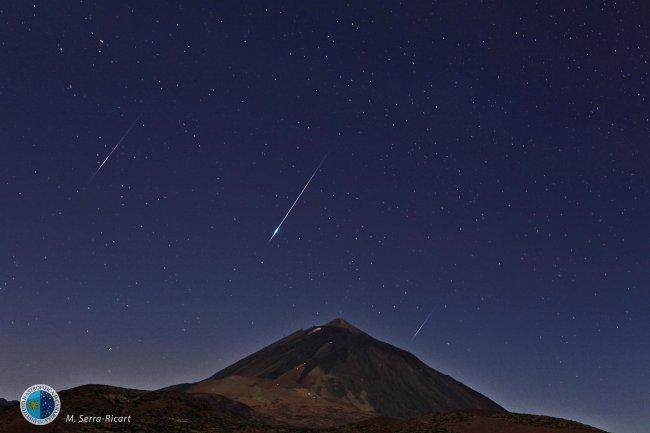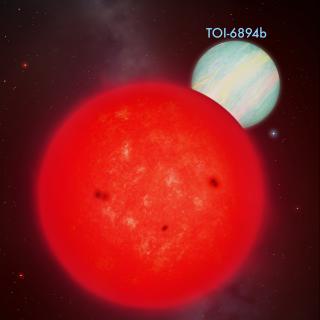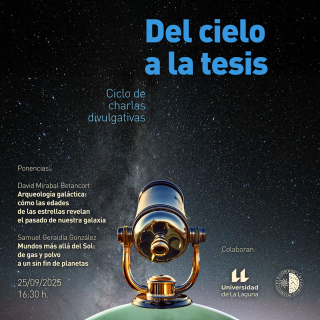As happens every year, the Perseids –also known popularly in Spain as “St Lawrence's tears”– show their peak of activity in mid-August. This year the activity of the Perseids will occur between July 17th and August 25th. However the maximum is expected between 13.00 h and 15.30 h Universal Time (UT, one hour more in the Canaries and two hours more in the Spanish peninsula) on August 12th.
In Europe the nights of August 11th to12th and 12th to 13th will be the best time to observe the Perseids, in other words the night before and the night following this maximum of activity, which will occur during the day. A waxing moon, which will set for the second half of the night, should not prove a problem to observe significant number of meteors (on average an observer should see one every two minutes), some of them very bright, (due to their high velocities on entering the atmosphere) if we are in a very dark place, without light pollution, and with a clear view to the horizon.
Miquel Serra-Ricart, an astronomer at the IAC comments: “With the Perseids we are sure to have a fine spectacle, because at the maximum of their activity they have maintained virtually constant activity, for the past ten years, of between 70 and 130 meteors per hour. The Perseids never let us down”.
A shower with a history
So-called “shooting stars” are really small particles of dust of different sizes, which are left behind by comets or asteroids as they orbit the sun.
Because of a melting process due to the sun's heat, these particles are thrown off, and as meteoroids they are spread around the orbit of the comet. Every year this orbit is crossed by the Earth on its journey round the sun. When they encounter the Earth's atmosphere, at high velocity, they disintegrate and leave the luminous tracks known to scientists as meteors.
The activity of the Eve Perseids, which originate from comet Swift-Tuttle (discovered in 1862) is around 100 meteors per hour (ZHR or zenith-crossings per hour). In the years close to perihelion (closest approach to the sun) of Swift-Tuttle, (the last was in1992, and the next will be iun 2126), this activity rises and can reach 400-500 meteors per hour, due to the high concentration of meteoroids which accompany the comet.
However the Perseids are known to have “bursts of activity” stimulated by the gravitational influence of the giant planets Jupiter and Saturn on the clouds of meteoroids which were ejected by the comet in the past.
In 1839 the German observer E. Heis made the first estimate of the maximum rate of activity of the Perseids: 160 meteors per hour. Afterwards, until 1858 the rate varied between 37 and 38 meteors per hour.Afterwards, until 1858, it variedbetween 37 and 38 meteors per hora. In 1920 the Perseids reached 200 per hour and in 1983 the number was 187.
According to the Russian astronomer Mikhail Maslov, this year we could see a rise in the activity of the Perseids due to the “Jupiter effect”. The giant planet attained its closest approach to the orbit of comet Swift-Tuttle, a distance of 257 million kilometres, in November 2014.Twenty two months are needed for the current of meteoroids to be pushed towards the Earth. Will the rate rise this year?
The European project STARS4ALL, a collabortion with the sky-live.tv portal will show the meteor shower live from the Canary Island Observatories. The total time of the transmission will be for 30 minutes, divided into two connections:
Connection 1. 12 agosto 19:30-19:45 TU (21:30-21:45 CEST, 20:30-20:45 Canary local time.
Connection 2: 12 agosto 23:15-23:30 TU (13 agosto 1:15-1:30 CEST, 00:15-00:30 Canary local time.
STARS4ALL (stars4all.eu) is a project funded by the H2020 Programme of the European Union, under contract number 688135. (Institutions collaborate in STARS4ALL( UPM, CEFRIEL, SOTON, ECN, ESCP Europe, IAC, IGB y UCM) in 6 European countries. The objective of STARS4ALL is to make the population aware of the problem of light pollution in many places where we live, and of the importance of taking measures to reduce it.
The Teide Cable-Car Company and SECAT (Society for the Study and Knowledge of Astronomy of Tenerife) are participating in the observation and transmission of the Perseids from the Peak of Teide (Tenerife). The Astronomical Group of Fuerteventura (AAF) and Cielos-La Palma will participate in the observation from Fuerteventura and La Palma, respectively.
Three Spanish supercomputing centres, CETA-Cimat (The Extremadura Centre for Advanced Techology) CSUC (Coucil of University Servers of Catalonia), and the CESGA (Galicia Supercomputing Centre), the Companies Canarcloud and Alared, and the IAC are participating in the distribution via the web portal (sky-live.tv). Siempreweb and Wolkam will participate in the streaming of the night-time cameras of MOBOTIX.
Citizen Science and Educational Activities
1) Calculation of Perseid activity
SOMYCE (The Society of Meteor and Comet Observers of Spain) have made an interesting proposal: to calculate the activity of the Perseids using visual observations. All the details can be found at: Perseidas 2016 - Campaña de Observación.
You can also participate in the calculation of the activity of the meteor shower by sending data to the International Meteor Association (IMO; información).
2) Calculating the height of formation of the meteors
At the Canary Island Observatories (IAC) the project AMOS-CI will carry out observations of the Perseids simultaneously from Tenerife (Teide Observatory) and La Palma (Roque de los Muchachos Observatory) which are separated by some 150 kilometres. With those data it should be possible to calculate the height of the formation of the meteors using parallax.
We encourage students to use the same technique, and apply it to the observations of the Perseids and of the Geminids obtained last year. The details can be found on the Didactic website “Cálculo altura de formación de meteoros” of astroaula.net.
More information
Meteor showers 2016
Audiovisual material
High resolution images of meteor showers:
https://www.flickr.com/photos/65131760@N06/sets/72157634760969777/
Videos of meteor showers:
https://www.youtube.com/playlist?list=PL6oc5e7lSjeJrCw26369dYUS-VExFHD40
NEWS
Videos and images Perseids 2016:
Perseid activity on the night of 11 to 12 August 2016 from the Observatorio del Teide (OT):
- Meteors video from Observatorio del Teide. Credits: STARS4ALL / sky-live.tv / IAC.
-
Timelapse showing meteors over IAC-80 telescope. Credits: STARS4ALL / sky-live.tv / IAC.
Composition of images showing the activity of the Perseids on the Observatorio del Roque de los Muchachos (ORM), the night of 11 to 12 August 2016:
Perseids on MAGIC telescopes at ORM.Credit: Daniel López (www.elcielodecanarias.com)



